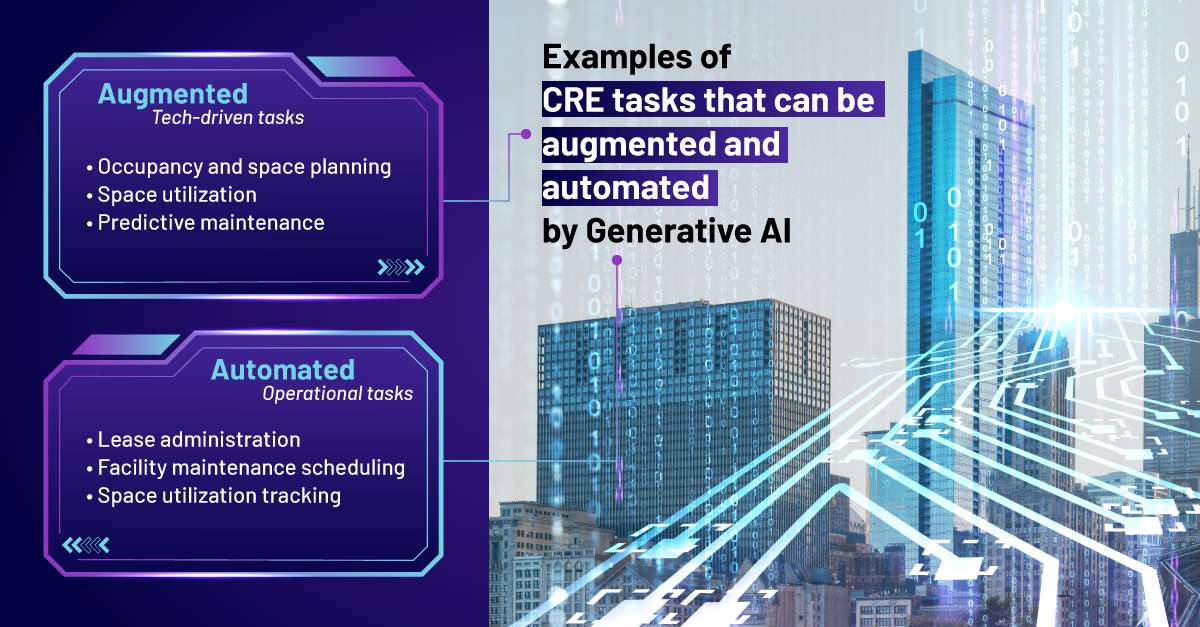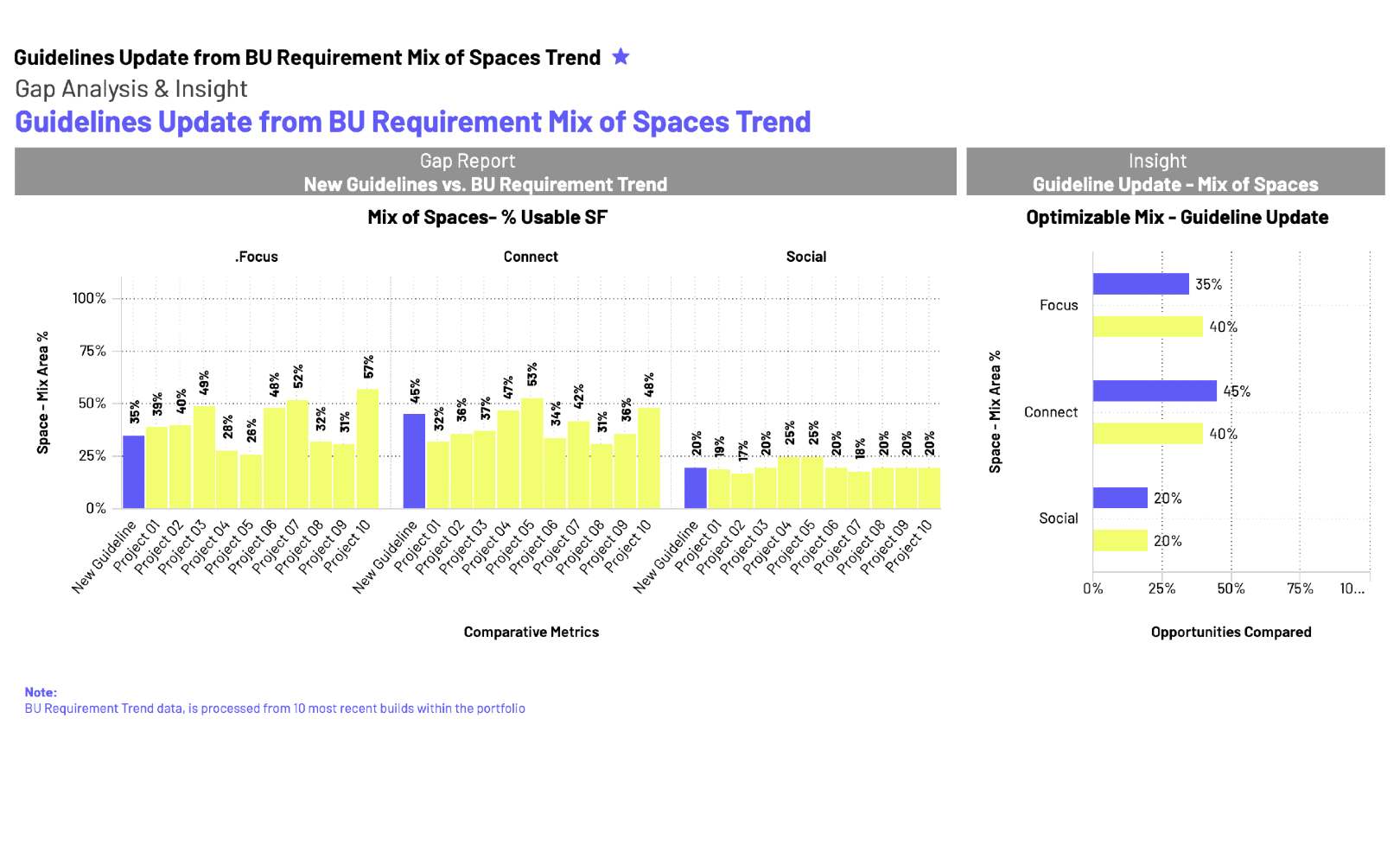Despite CRE’s sloth-like pace with new technologies, putting AI behind the wheel of office design is a genuine opportunity to transform spaces and our ways of working for the better. Here’s how we can minimize the limitations and take advantage of its power.
For all its potential, AI is still a point of contention. We’re worried that it will steal our jobs or that we’ll fall for the hype, and it will be just another “shiny object” sold to us by the media or clever marketing.
But AI is here to stay, so better to embrace it and have it work for your organization’s best interests. McKinsey estimates that Generative AI could add $4.4 trillion to the global economy annually. But CRE, in particular, is in no hurry to take advantage of this opportunity in the workplace. According to McKinsey’s insights, real estate is the second least open to AI after agriculture. Furthermore, according to a recent research by Accenture, 66% of leaders recognize that they and their direct reports lack practical understanding of what technology and data can achieve.
Can we really trust it to transform the office, after all? Should we stick to good old-fashioned human thought and insights? Now more than ever, workplace teams could use a helping hand with all the data noise surrounding today’s workplace.
Luckily, many AI-powered tools already exist to help CRE, so the opportunity to transform the workplace is already here. Instead of sitting on our laurels and waiting for others to make the first move, here’s how to become more open to AI.
Benefits of using AI in workplace teams
If you want increased efficiency and productivity, look no further than AI to free up some of those human hours. What takes us hours, weeks, and months to complete can often be done by AI in minutes.

Artificial intelligence can streamline workflows and processes and is excellent for automating manual tasks, programming, analyzing data, and identifying patterns that humans may be less skilled at.
Another advantage of AI is offering unbiased suggestions, at least in terms of the workplace. While we mere mortals have experience, biases, and self- and peer-imposed ‘rulebooks’ about what good design is and isn’t, AI will look objectively at the data on how your office is being used and offer suggestions on how it could be improved.
The downstream effects of getting more done in less time include enhanced decision-making, knowing you can move forward from solid foundations, and unlocking money savings. With AI, you can break ground and get to day one much faster, confidently handing over the building plans and helping reduce change orders.
Your employees already use AI at work
Employees already seem to be on board with AI even if some companies aren’t, with 75% of global knowledge workers using gen AI at work, according to the 2024 Work Trend Index Annual Report from Microsoft and LinkedIn.
One key takeaway from the report is to channel that enthusiasm into business transformation. This is particularly true with CRE, as it isn’t totally digitally transformed like other industries.
The report suggests getting started by identifying a business problem and applying AI. So why not the workplace? Capital projects are riddled with inefficient processes, and AI could effortlessly speed up the process X-fold.

The limitations of AI in the workplace
Artificial intelligence isn’t a silver bullet; you’d probably be disappointed if you figured you could solve all your problems with automation. It’s best to think of AI as an efficiency enhancer, an extension of us if you like, rather than a replacement.
As we already touched on, CRE needs to digitally transform to lay strong foundations for automation. Without owning all our data and having it in an intelligent format, we won’t gain any value from AI.
If your data is static—held in spreadsheets while your workplace guidelines are in a PDF—your output may not be of the highest quality or draw from out-of-date guidelines and is, therefore, unreliable.
Artificial intelligence is only as good as the data it ingests. Thought leader Kevin Sauer noted in a recent blog, “As the saying goes, ‘garbage in, garbage out.’” Think of it like a sports car—putting higher-viscosity oil in it will give you better performance.
One way to weigh up using AI is to consider how your time would be best spent. As a workplace strategist, you could reinvest your time from manual test fits to AI into being creative or talking to stakeholders about what they like or dislike about a design proposal.
Would it be better spent on addressing the crux of problems and strategy or on menial tasks that could probably be performed better with automation?
What workplace AI tech is worth exploring?
You don’t have to look far to see AI already disrupting various functions, including CRM systems, customer services, and content creation.
Plenty of automation opportunities are already available for CRE, from Qbiq’s automated office layout plans to Gospace’s automated space scheduling. Artificial intelligence can also offer insights for CRE, as with JLL GPT.
Then there’s Saltmine, our holistic, all-in-one solution. With one centralized platform, you can leverage AI to ingest and analyze data, generate recommendations, create 3D walkthroughs and renders, and facilitate feedback. Saltmine replaces your existing, outdated tech stack, so you’re not just adding another tool to your already toppling list of technologies.

Conclusion: Is now the time to trust AI?
Artificial intelligence isn’t perfect yet, but forward-thinking companies are already harnessing its power to save time and money while enhancing creativity, innovation and efficiency. And if CRE is notoriously slow to keep up, now’s your chance to separate yourself from the pack.
Rome wasn’t built in a day, so take inspiration from the Microsoft and LinkedIn report, start with one problem (like the workplace), and see how AI can help solve it. Could it give you some insights you wouldn’t otherwise have, or take a few tasks off your plate while you focus on what’s important?
For more on how AI can unlock opportunities in CRE (without taking our jobs), check out this recent blog from CRE technology expert Martin Byrne.
Enjoying our blog? Be sure to subscribe to stay up-to-date on Saltmine's original content with the form below!


